Internet of Things (IoT) - Demystified
Saraju P. Mohanty
Department of Computer Science and Engineering
University of North Texas, Denton, TX 76207, USA.
Homepage: http://www.smohanty.org/
Email: saraju.mohanty@unt.edu
Abstract: The Internet of Things (IoT) is considered as the core technology that can enable the design and operation of smart cities. TheIoTmakes components of smart cities, which need not be inherently smart or intelligent, smart or intelligent. For example, owing to IoT, buildings, energy-grids, transport-systems, and health-care systemsaremade smart or intelligent.IoT can be regarded as a configurable dynamic global network of networks consisting of four main components: (1) The Things, (2) Internet, (3) LAN, and (4) The Cloud. The “Things” refers to any physical object that has its own IP address and can connect andsend/receive data via network. TheIoT infrastructure consists of various components including sensors, electronics, networks, middleware, firmware, and software. This talk will present detailed insight of IoT. The talk will address many questions about IoTincluding the following: (1) What is IoT? (2) What are the critical components of IoT? (3) What are the challenges of design and operation of IoT? (4) How to performDesign for excellence (DFX) of IoT"Things"? (5) How can one simulate an IoT framework consisting of multidiscipline systems and components of IoT before its actual deployment? (6) What is the state-of-the-art in IoT and future direction?
Speaker Biography:
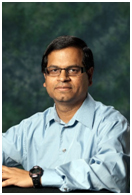 Dr. Saraju P. Mohanty is a Professor at the Department of Computer Science and Engineering (CSE), University of North Texas (UNT). He obtained a Ph.D. in Computer Engineering from the University of South Florida (USF) in 2003, a Master’s degree in Systems Science and Automation (SSA) from the Indian Institute of Science (IISc), Bangalore, India in 1999. Prof. Mohanty was conferred the Glorious India Award in 2017 for his exemplary contributions to the discipline. He received Society for Technical Communication (STC) 2017 Award of Merit for his outstanding contributions to IEEE Consumer Electronics Magazine. He was the recipient of 2016 PROSE Award for best Textbook in Physical Sciences & Mathematics from the Association of American Publishers for his book titled "Nanoelectronic Mixed-Signal System Design" published by McGraw-Hill in 2015.He received 2016-17 UNT Toulouse Scholars Award for sustained excellent scholarly and teaching achievements. Prof. Mohanty's research is in “Energy-Efficient High-Performance Secure Electronic Systems”. Prof. Mohanty's research has been funded by National Science Foundation (NSF), Semiconductor Research Corporation (SRC), and USA Air Force. Dr. Mohanty is an inventor of 4 US patents. Prof. Mohanty is an author of 220 peer-reviewed journal and conference articles, and 3 books. He serves as the Editor-in-Chief (EiC) of the IEEE Consumer Electronics Magazine. Prof. Mohanty has been serving on the editorial board of several peer-reviewed international journals or transactions, including IEEE Transactions on Computer-Aided Design of Integrated Circuits and Systems (TCAD) and ACM Journal on Emerging Technologies in Computing Systems (JETC). Prof. Mohanty serves as the Chair of Technical Committee on Very Large Scale Integration (TCVLSI), IEEE Computer Society (IEEE-CS),after elected by a global ballot to oversee a dozen of IEEE conferences. He serves on the steering, organizing, and program committees of several international conferences including ISVLSI, iNIS, and ICCE.
Dr. Saraju P. Mohanty is a Professor at the Department of Computer Science and Engineering (CSE), University of North Texas (UNT). He obtained a Ph.D. in Computer Engineering from the University of South Florida (USF) in 2003, a Master’s degree in Systems Science and Automation (SSA) from the Indian Institute of Science (IISc), Bangalore, India in 1999. Prof. Mohanty was conferred the Glorious India Award in 2017 for his exemplary contributions to the discipline. He received Society for Technical Communication (STC) 2017 Award of Merit for his outstanding contributions to IEEE Consumer Electronics Magazine. He was the recipient of 2016 PROSE Award for best Textbook in Physical Sciences & Mathematics from the Association of American Publishers for his book titled "Nanoelectronic Mixed-Signal System Design" published by McGraw-Hill in 2015.He received 2016-17 UNT Toulouse Scholars Award for sustained excellent scholarly and teaching achievements. Prof. Mohanty's research is in “Energy-Efficient High-Performance Secure Electronic Systems”. Prof. Mohanty's research has been funded by National Science Foundation (NSF), Semiconductor Research Corporation (SRC), and USA Air Force. Dr. Mohanty is an inventor of 4 US patents. Prof. Mohanty is an author of 220 peer-reviewed journal and conference articles, and 3 books. He serves as the Editor-in-Chief (EiC) of the IEEE Consumer Electronics Magazine. Prof. Mohanty has been serving on the editorial board of several peer-reviewed international journals or transactions, including IEEE Transactions on Computer-Aided Design of Integrated Circuits and Systems (TCAD) and ACM Journal on Emerging Technologies in Computing Systems (JETC). Prof. Mohanty serves as the Chair of Technical Committee on Very Large Scale Integration (TCVLSI), IEEE Computer Society (IEEE-CS),after elected by a global ballot to oversee a dozen of IEEE conferences. He serves on the steering, organizing, and program committees of several international conferences including ISVLSI, iNIS, and ICCE.
More about his biography, research, education, and outreach activities can be obtained from his website: http://www.smohanty.org.
Smart Classrooms: Technology-Aids for Effective Teaching and Learning
Bhaskaran Raman
Department of Computer Science and Engineering Indian Institute of Technology, Bombay.
Powai, Mumbai, INDIA 400076
Homepage: http://www.cse.iitb.ac.in/silmaril/br/doku.php
Email: username is br, domain is cse dot iitb dot ac dot in
Abstract:
Worldwide, the demand for quality education is high, unfortunately far exceeding its supply. While there's no panacea, we see an opportunity to alleviate some of these quality and scale problems, taking appropriate aid of technology. We have developed two tools: BodhiTree and SAFE. This talk will provide an overview of these and we also invite teachers to use these platforms.
BodhiTree is a publishing platform which hosts “interactive” multimedia books. Our interactivity model is based on Socratic method of teaching which is based on asking and answering questions (which are embedded within videos). BodhiTree provides an interface for instructors to use these books to manage their course offering. An important feature of the platform is that it also permits conduction and auto/manual evaluation of objective, laboratory and programming exams/assignments. All in all, it provides a rich set of features to instructors to run their courses effectively while minimizing their load.
SAFE (Smart, Authenticated, Fast Exams) is a tool that enables continuous assessment in the form of regular/weekly quizzes in classes. SAFE is based on a BYOD (bring your own device) model that leverages student smart-phones to conduct auto-graded, cheating-free exams in a proctored classroom setting. SAFE has 3 components: a smart-phone app, a web server and WiFi infrastructure to enable app-server communication. SAFE supports a rich set of features to handle various types of question papers as well as instructor preferences. SAFE achieves 4 goals: easy setup, cheating-free operation, robustness and scale. SAFE has been used so far to conduct 200+ in-class quizzes in 14 courses in the last 2 year. The feedback from end-users has been very positive.
BodhiTree is at: http://bodhitree.cse.iitb.ac.in/
SAFE is at: http://safe.cse.iitb.ac.in/
Speaker Biography:
 Bhaskaran Raman received his B.Tech in Computer Science and Engineering from Indian Institute of Technology, Madras in May 1997. He received his M.S. and Ph.D. in Computer Science from University of California, Berkeley, in 1999 and 2002 respectively. He was a faculty in the CSE department at Indian Institute of Technology, Kanpur (India) from June 2003. Since July 2007, he is a faculty at the CSE department at Indian Institute of Technology, Bombay (India). His research interests and expertise are in communication networks, wireless/mobile networks, and technology for education. His current focus and specific interests are mobile crowdsensing, WiFi performance diagnosis, and use of technology in large classrooms for effective teaching.
Bhaskaran Raman received his B.Tech in Computer Science and Engineering from Indian Institute of Technology, Madras in May 1997. He received his M.S. and Ph.D. in Computer Science from University of California, Berkeley, in 1999 and 2002 respectively. He was a faculty in the CSE department at Indian Institute of Technology, Kanpur (India) from June 2003. Since July 2007, he is a faculty at the CSE department at Indian Institute of Technology, Bombay (India). His research interests and expertise are in communication networks, wireless/mobile networks, and technology for education. His current focus and specific interests are mobile crowdsensing, WiFi performance diagnosis, and use of technology in large classrooms for effective teaching.
More about his biography, research, education, and outreach activities can be obtained from his website: http://www.cse.iitb.ac.in/silmaril/br/doku.php
Integrative AI-based Modeling of Biomedical Data for Precision Medicine
Prof. Vanathi GopalakrishnanDepartment of Biomedicial Informatics
University of Pittsburgh, Pennsylvania, USA
Abstract: The era of precision medicine is upon us, made possible by the enormous technological progress in biomedicine allowing us to study the genotypes and phenotypes contributing to health and disease. The vast amounts of biomedical data pose a major problem in terms of standardization and analysis. Moreover, the biomedical data collected for any single person varies in type – for example, it can come from text-based medical records of clinical assesments, and from screening tests that measure biomarkers in biological samples or extract them from radiologic images. In this talk, I will provide an overview of innovative methods that are being developed in my laboratory for integrative modeling of biomedical data, emphasizing the motivation for Artificial Intelligence (AI)-based research in this area. Furthermore, through real-world case studies, I will identify the challenges involved in predictive modeling from different types of biomedical data, state-of-the-art solutions, and the promise of integrative AI-based modeling for precision medicine.
Speaker Biography
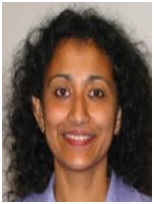 Vanathi Gopalakrishnan obtained her B.E. degree in Computer Science and Technology from the B.MS. College of Engineering, Bangalore, India and subsequently obtained the Masters and PhD degrees in Computer Science from the University of Pittsburgh (UPitt) in Pittsburgh, PA, USA. She was a co-founder of a small business that automated second reading of mammogram images for breast cancer screening. She is currently a tenured Associate Professor in the Department of Biomedical Informatcs, in UPitt’s School of Medicine, with secondary appointments in the Intelligent Systems Program and the Department of Computational and Systems Biology. She pioneered the introduction of Bioinformatics courses within the core curriculum of the Biomedical Informatics Training Program, and has subsequently been involved in several innovative training programs including the Joint CMU-Pitt Ph.D. program in Computational Biology. She directs the PRoBE laboratory for Pattern Recognition from Biomedical Evidence. Her research involves predictive modeling from big biomedical datasets, with a focus on transforming imaging and biomarker data into actionable knowledge to enable precision medicine and translational bioinformatics. She has mentored many award-winning students. Her laboratory has been funded continuously for their innovative research over the past 15 years by several NIH Institutes in the USA, particularly the National Institute of General Medical Sciences (NIGMS), the National Library of Medicine (NLM) and the National Cancer Instiute (NCI). She has contributed to projects funded by the National Science Foundation (NSF) and the Department of Defense (DoD).
Vanathi Gopalakrishnan obtained her B.E. degree in Computer Science and Technology from the B.MS. College of Engineering, Bangalore, India and subsequently obtained the Masters and PhD degrees in Computer Science from the University of Pittsburgh (UPitt) in Pittsburgh, PA, USA. She was a co-founder of a small business that automated second reading of mammogram images for breast cancer screening. She is currently a tenured Associate Professor in the Department of Biomedical Informatcs, in UPitt’s School of Medicine, with secondary appointments in the Intelligent Systems Program and the Department of Computational and Systems Biology. She pioneered the introduction of Bioinformatics courses within the core curriculum of the Biomedical Informatics Training Program, and has subsequently been involved in several innovative training programs including the Joint CMU-Pitt Ph.D. program in Computational Biology. She directs the PRoBE laboratory for Pattern Recognition from Biomedical Evidence. Her research involves predictive modeling from big biomedical datasets, with a focus on transforming imaging and biomarker data into actionable knowledge to enable precision medicine and translational bioinformatics. She has mentored many award-winning students. Her laboratory has been funded continuously for their innovative research over the past 15 years by several NIH Institutes in the USA, particularly the National Institute of General Medical Sciences (NIGMS), the National Library of Medicine (NLM) and the National Cancer Instiute (NCI). She has contributed to projects funded by the National Science Foundation (NSF) and the Department of Defense (DoD).
Department of Biomedical Informatics
University of Pittsburgh, Pittsburgh,USA PA 15213
Email: madhavi@pitt.edu
Abstract: In the previous one or two decades, a number of technological methods have been developed in the field of biology that have made it possible to measure several “system-level” aspects of living things. These biotechnologies have been applied to study a wide spectrum of aspects: data pertaining to different organisms (bacteria to human), different tissues/cell types within human (neurons, heart, blood, skin, etc), different aspects of a cell (genome, proteome, gene-expression, methylation), different scales of population (reference genome, 1000 Genomes, UK 10kGenomes), different conditions (“normal” population versus disease subpopulations), and many more. Data generated in the last 10 years has grown to very large scale, and the advancements made with this data in biomedical science have been heartening. The new data opened up avenues for computational scientists to contribute – not only as software developers and engineers, but as scientists who directly contribute to advancement of biology. They have been able to present computationally predicted results which when translated by biologists through experimental ‘validations’ have resulted in very valuable discoveries: from understanding the disease mechanisms to proposing therapeutics. This talk will introduce some of the algorithms we developed for studying biological data, with an analogy to language modeling and network analysis that the Information and Communications Technologies community can relate to, and the results that these algorithms produced that were translated to biology.
Speaker Biography
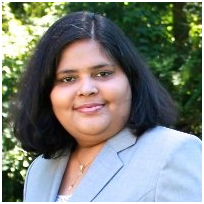 Madhavi Ganapathiraju received Ph.D. from Carnegie Mellon University School of Computer Science in Language and Information Technologies and M.Engg. degree from Indian Institute of Science in Electrical Communications Engineering. She is a graduate of A.R.S.D. College of Delhi University where she obtained B.S. in Electronics, Physics and Mathematics. She is currently Associate Professor at the Department of Biomedical Informatics of University of Pittsburgh School of Medicine. She holds secondary appointments at Intelligent Systems Program of University of Pittsburgh School of Arts and Sciences.She holds adjunct appointment at Molecular and Cellular Cancer Biology Program of UPMCHillman Cancer Center, and Language Technologies Institute of Carnegie Mellon University School of Computer Science. She is a Faculty of Biomedical Informatics Training Program (www.dbmi.pitt.edu), Intelligent Systems Program (www.isp.pitt.edu), Joint CMU-Pitt Computational Biology Program (www.compbio.cmu.edu) and Integrated Systems Biology Program(www.isb.pitt.edu) of University of Pittsburgh. She is on the Advisory Board of Biotechnology Innovation and Computing Program (http://bic.cs.cmu.edu) of Carnegie Mellon University. Her work presented here isfunded by the Biobehavioral Research Awards for Innovative New Scientists (BRAINS) grant from National Institute of Mental Health of the National Institutes of Health, USA. Her publications may be viewed at http://tinyurl.com/MadhaviCMUscholar
Madhavi Ganapathiraju received Ph.D. from Carnegie Mellon University School of Computer Science in Language and Information Technologies and M.Engg. degree from Indian Institute of Science in Electrical Communications Engineering. She is a graduate of A.R.S.D. College of Delhi University where she obtained B.S. in Electronics, Physics and Mathematics. She is currently Associate Professor at the Department of Biomedical Informatics of University of Pittsburgh School of Medicine. She holds secondary appointments at Intelligent Systems Program of University of Pittsburgh School of Arts and Sciences.She holds adjunct appointment at Molecular and Cellular Cancer Biology Program of UPMCHillman Cancer Center, and Language Technologies Institute of Carnegie Mellon University School of Computer Science. She is a Faculty of Biomedical Informatics Training Program (www.dbmi.pitt.edu), Intelligent Systems Program (www.isp.pitt.edu), Joint CMU-Pitt Computational Biology Program (www.compbio.cmu.edu) and Integrated Systems Biology Program(www.isb.pitt.edu) of University of Pittsburgh. She is on the Advisory Board of Biotechnology Innovation and Computing Program (http://bic.cs.cmu.edu) of Carnegie Mellon University. Her work presented here isfunded by the Biobehavioral Research Awards for Innovative New Scientists (BRAINS) grant from National Institute of Mental Health of the National Institutes of Health, USA. Her publications may be viewed at http://tinyurl.com/MadhaviCMUscholar
Heterogeneous Multi-Processor Pipelines: A Real-Time MPSoC Story
Prof. Sri ParameswaranProgram Director Computer Engineering
University of New South Wales Australia
Abstract:
Several modern systems, from ubiquitous mobile phones to powerful gaming machines, contain multiple heterogeneous processing cores. In a modern phone, for example, a general purpose processor manages the human machine interface, while a DSP manages the baseband signal processing. Usually, these heterogeneous multi-processor systems isolate tasks, and execute the isolated tasks in separate processors.
In this talk a novel heterogeneous multiprocessor pipeline system is described, where a single real-time streaming application is executed by multiple processors. The processors in the system are connected in a pipeline via queues (FIFOs) which allow communication at a higher bandwidth, devoid of the contention exhibited by typical shared bus architecture. Recent developments in Application Specific Instruction Set Processors (particularly from Tensilica Inc), have driven the creation of these multi processor pipelines with ASIPs as the building blocks. Each ASIP in the pipeline is customized with differing additional instructions, and instruction and data cache sizes to improve performance of the task mapped on that particular ASIP. As a result, the performance of the whole system is improved, while minimizing the increase in area. The permutation of configurations for each ASIP make up the design space of the pipelined multiprocessor system, and is rapidly explored. An automated design methodology to choose the best ASIP configurations as the final design in a reasonable amount of time is shown. The rapid exploration methodology used is able to explore design spaces up to 10^16 design points, which is almost impossible to explore otherwise. Finally, the possibilities of merging pipeline systems are discussed.
Speaker Biography
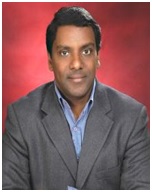 Sri Parameswaran is a Professor in the School of Computer Science and Engineering at the University of New South Wales. He also serves as the Program Director for Computer Engineering. His research interests are in System Level Synthesis, Low power systems, High Level Systems and Network on Chips. In addition to serving as the Editor in Chief of the IEEE Embedded Systems Letters, he serves or has served on the editorial boards of IEEE Transactions on Computer Aided Design, ACM Transactions on Embedded Computing Systems, the EURASIP Journal on Embedded Systems and the Design Automation of Embedded Systems. He has served on the Program Committees of Design Automation Conference (DAC), Design and Test in Europe (DATE), the International Conference on Computer Aided Design (ICCAD), the International Conference on Hardware/Software Code-sign and System Synthesis (CODES-ISSS), and the International Conference on Compilers, Architectures and Synthesis for Embedded Systems (CASES).
Sri Parameswaran is a Professor in the School of Computer Science and Engineering at the University of New South Wales. He also serves as the Program Director for Computer Engineering. His research interests are in System Level Synthesis, Low power systems, High Level Systems and Network on Chips. In addition to serving as the Editor in Chief of the IEEE Embedded Systems Letters, he serves or has served on the editorial boards of IEEE Transactions on Computer Aided Design, ACM Transactions on Embedded Computing Systems, the EURASIP Journal on Embedded Systems and the Design Automation of Embedded Systems. He has served on the Program Committees of Design Automation Conference (DAC), Design and Test in Europe (DATE), the International Conference on Computer Aided Design (ICCAD), the International Conference on Hardware/Software Code-sign and System Synthesis (CODES-ISSS), and the International Conference on Compilers, Architectures and Synthesis for Embedded Systems (CASES).
Extracting and Utilizing Information from Microblogs during Disaster
Prof. Niloy GangulyDepartment of Computer Science and Engineering
Indian Institute of Technology, Kharagpur India
Research Interests: social networks modeling, complex network theory, mobile computing.
Abstract: Microblogging platforms such as Twitter provide rapid access to situation-sensitive information that people post during mass convergence events such as natural or man-made disasters. When a disaster happens, responders to disasters use such information obtained from microblogging sites to plan and respond to the needs of people located in disaster areas. However, situational information is immersed among hundreds of thousands of tweets, mostly containing sentiments and opinion of the masses, that are posted during such events. Further, these large volume of situational tweet streams are scattered across various humanitarian categories like 'infrastructure damage', 'missing or found people', 'shelter and service', 'volunteer service' etc. These humanitarian categories contain information about various small scale sub-events like ‘airport shut’, ‘building collapse’ etc. To effectively utilize microblogging sites during disaster events, it is necessary to (i) extract the situational information from among the large amounts of sentiment and opinion, (ii) identify various humanitarian categories and small scale sub-events from situational tweet stream, and (iii) summarize the situational information in real time, to help decision making processes when time is critical. In this work, we have proposed different solutions to address above mentioned challenges.
Speaker Biography
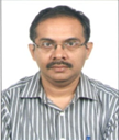 Niloy Ganguly is a professor in the Department of Computer Science and Engineering at the Indian Institute of Technology Kharagpur. He has received his PhD from Bengal Engineering and Science University, Calcutta, India and his Bachelors in Computer Science and Engineering from the Indian Institute of Technology (IIT) at Kharagpur. He has been a post-doctoral fellow in Technical University of Dresden, Germany where he has worked in the EU-funded project Biology-Inspired Techniques for Self-Organization in Dynamic Networks (BISON).
Niloy Ganguly is a professor in the Department of Computer Science and Engineering at the Indian Institute of Technology Kharagpur. He has received his PhD from Bengal Engineering and Science University, Calcutta, India and his Bachelors in Computer Science and Engineering from the Indian Institute of Technology (IIT) at Kharagpur. He has been a post-doctoral fellow in Technical University of Dresden, Germany where he has worked in the EU-funded project Biology-Inspired Techniques for Self-Organization in Dynamic Networks (BISON).
Ganguly presently focuses on different aspects of Online Social Networks (OSN), urban and mobile computing. His primary contributions to the domain of OSN include understanding the importance of link-farming and discovering experts in OSN as well as modeling opinion dynamics over social network. He has also contributed to various theoretical issues related to dynamical large networks often termed as complex networks. In this line, he has been instrumental in organizing the workshop series Dynamics On and Of Complex Networks in European Conference on Complex Systems and several complex system related conferences.
He has published around 150 papers in international conferences and journals. He has also edited a book on Complex Networks published by Birkhauser, Boston. He currently publishes in various top ranking international journals and conferences including: WWW, KDD, SIGIR, IJCAI, CIKM, ICDM, ICWSM, CSCW, ACL, EMNLP, INFOCOM, Euro Physics Letters, Physical Review E, ACM and IEEE Transactions.
For additional information on Niloy Ganguly, please click here.He also leads a very active research group – named CNeRG: Complex Network Research Group.
For more information, please visit: http://www.facweb.iitkgp.ernet.in/~niloy/
The Next Era: Deep Learning for Biomedical Research
Parthiban SrinivasanIndia
Research Interests:Innovation, Research & Development,Technical Program Management,Data Science, Machine Learning, Deep Learning,Cheminformatics, CADD and Computational Chemistry
Abstract: Deep learning is hot, making waves, delivering results, and is somewhat of a buzzword today. There is a desire to apply deep learning to anything that is digital. Unlike the brain, these artificial neural networks have a very strict predefined structure. The brain is made up of neurons that talk to each other via electrical and chemical signals. We do not differentiate between these two types of signals in artificial neural networks. They are essentially a series of advanced statistics based exercises that review the past to indicate the likely future. Another buzzword that was used for the last few years across all industries is “big data”. In biomedical and health sciences, both unstructured and structured information constitute "big data". On the one hand deep learning needs lot of data whereas “big data" has value only when it generates actionable insight. Given this, these two areas are destined to be married. The couple is made for each other. The time is ripe now for a synergistic association that will benefit the pharmaceutical companies. It may be only a short time before we have vice presidents of machine learning or deep learning in pharmaceutical and biotechnology companies. This presentation will review the prominent deep learning methods and discuss these techniques for their usefulness in biomedical and health informatics
Speaker Biography
 Parthiban Srinivasan is the CEO of VINGYANI, a data science company deals with Informatics 2.0, that is, Deep learning, Natural Language Processing and Machine Learning for Drug Discovery and Health. He is an experienced data scientist, earned his PhD from Indian Institute of Science, specializing in Computational Chemistry. He holds dual Masters Degree- one in Science and the other in Engineering. After his PhD, he continued the research at NASA Ames Research Center (USA) and Weizmann Institute of Science (Israel). Then he worked at AstraZeneca in the area of Computer Aided Drug Design for Tuberculosis. Later, he headed informatics business units in Jubilant Biosys and then in GvkBio before he floated the company, Parthys Reverse Informatics. Now his recent venture is VINGYANI.
Parthiban Srinivasan is the CEO of VINGYANI, a data science company deals with Informatics 2.0, that is, Deep learning, Natural Language Processing and Machine Learning for Drug Discovery and Health. He is an experienced data scientist, earned his PhD from Indian Institute of Science, specializing in Computational Chemistry. He holds dual Masters Degree- one in Science and the other in Engineering. After his PhD, he continued the research at NASA Ames Research Center (USA) and Weizmann Institute of Science (Israel). Then he worked at AstraZeneca in the area of Computer Aided Drug Design for Tuberculosis. Later, he headed informatics business units in Jubilant Biosys and then in GvkBio before he floated the company, Parthys Reverse Informatics. Now his recent venture is VINGYANI.
For more information, please visit: https://www.linkedin.com/in/parthiban-srinivasan-183608b/